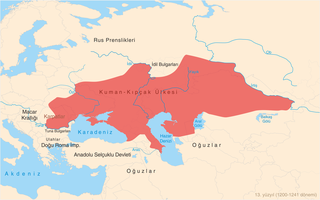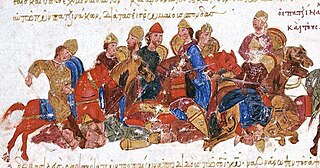
The Göktürks, Türks, Celestial Turks or Blue Turks were a Turkic people in medieval Inner Asia. The Göktürks, under the leadership of Bumin Qaghan and his sons, succeeded the Rouran Khaganate as the main power in the region and established the First Turkic Khaganate, one of several nomadic dynasties that would shape the future geolocation, culture, and dominant beliefs of Turkic peoples.

De Administrando Imperio is a Greek-language work written by the 10th-century Byzantine Emperor Constantine VII. It is a domestic and foreign policy manual for the use of Constantine's son and successor, the Emperor Romanos II. It is a prominent example of Byzantine encyclopaedism.

Árpád was the head of the confederation of the Magyar tribes at the turn of the 9th and 10th centuries. He might have been either the sacred ruler or kende of the Hungarians, or their military leader or gyula, although most details of his life are debated by historians, because different sources contain contradictory information. Despite this, many Hungarians refer to him as the "founder of our country", and Árpád's preeminent role in the Hungarian conquest of the Carpathian Basin has been emphasized by some later chronicles. The dynasty descending from Árpád ruled the Kingdom of Hungary until 1301.

The Turul is a mythological bird of prey, mostly depicted as a falcon, in Hungarian tradition and Turkic tradition, and a national symbol of Hungarians.
The Kabars, also known as Qavars (Qabars) or Khavars were Khazar rebels who joined Magyar tribes and the Rus' Khaganate confederations in the 9th century CE.

The Kipchaks or Qipchaqs, also known as Kipchak Turks or Polovtsians, were Turkic nomads and then a confederation that existed in the Middle Ages inhabiting parts of the Eurasian Steppe.

The Holy Crown of Hungary, also known as the Crown of Saint Stephen, named in honour of Saint Stephen I of Hungary, was the coronation crown used by the Kingdom of Hungary for most of its existence; kings were crowned with it since the twelfth century. The Crown symbolized the King's authority over the Lands of the Hungarian Crown, and it was a key mark of legitimacy. Through the history of Hungary, more than fifty kings were crowned with it, with the last being Charles IV in 1916. The only kings not so crowned were Wladyslaw I, John Sigismund Zápolya, and Joseph II.

The Pechenegs or Patzinaks were a semi-nomadic Oghuz Turkic people from Central Asia who spoke the Pecheneg language. In the 9th and 10th centuries, the Pechenegs controlled much of the steppes of southeast Europe and the Crimean Peninsula. In the 9th century the Pechenegs began a period of wars against Kievan Rus', and for more than two centuries launched raids into the lands of Rus', which sometimes escalated into full-scale wars.

Ajtony, Ahtum or Achtum was an early-11th-century ruler in the territory now known as Banat in present Romania and Serbia. His primary source is the Long Life of Saint Gerard, a 14th-century hagiography. Ajtony was a powerful ruler who owned many horses, cattle and sheep and was baptised according to the Orthodox rite in Vidin. He taxed salt which was transferred to King Stephen I of Hungary on the Mureș River. The king sent Csanád, Ajtony's former commander-in-chief, against him at the head of a large army. Csanád defeated and killed Ajtony, occupying his realm. In the territory, at least one county and a Roman Catholic diocese were established.

The trade route from the Varangians to the Greeks was a medieval trade route that connected Scandinavia, Kievan Rus' and the Eastern Roman Empire. The route allowed merchants along its length to establish a direct prosperous trade with the Empire, and prompted some of them to settle in the territories of present-day Belarus, Russia and Ukraine. The majority of the route comprised a long-distance waterway, including the Baltic Sea, several rivers flowing into the Baltic Sea, and rivers of the Dnieper river system, with portages on the drainage divides. An alternative route was along the Dniester river with stops on the western shore of Black Sea. These more specific sub-routes are sometimes referred to as the Dnieper trade route and Dniester trade route, respectively.

Levedi, or Lebed, Levedias, Lebedias, and Lebedi was a Hungarian chieftain, the first known leader of the Hungarians.
Sumbat I was a Georgian prince of the Bagratid dynasty of Tao-Klarjeti and hereditary ruler of Klarjeti from c. 870 until his death.

The Grand Principality of Hungary or Duchy of Hungary was the earliest documented Hungarian state in the Carpathian Basin, established in 895 or 896, following the 9th century Magyar invasion of the Carpathian Basin.

Turkey, officially the Republic of Türkiye, is a country mainly located in Anatolia in West Asia, with a smaller part called East Thrace in Southeast Europe. It borders the Black Sea to the north; Georgia, Armenia, Azerbaijan, and Iran to the east; Iraq, Syria, and the Mediterranean Sea to the south; and the Aegean Sea, Greece, and Bulgaria to the west. Turkey is home to over 85 million people; most are ethnic Turks, while ethnic Kurds are the largest ethnic minority. Officially a secular state, Turkey has a Muslim-majority population. Ankara is Turkey's capital and second-largest city, while Istanbul is its largest city and economic and financial center. Other major cities include İzmir, Bursa, and Antalya.

The Eastern Turkic Khaganate was a Turkic khaganate formed as a result of the internecine wars in the beginning of the 7th century after the First Turkic Khaganate had splintered into two polities – one in the east and the other in the west. Finally, the Eastern Turkic Khaganate was defeated and absorbed by the Tang dynasty, and Xueyantuo occupied the territory of the former Turkic Khaganate.
The First Turkic Khaganate, also referred to as the First Turkic Empire, the Turkic Khaganate or the Göktürk Khaganate, was a Turkic khaganate established by the Ashina clan of the Göktürks in medieval Inner Asia under the leadership of Bumin Qaghan and his brother Istämi. The First Turkic Khaganate succeeded the Rouran Khaganate as the hegemonic power of the Mongolian Plateau and rapidly expanded their territories in Central Asia. The khaganate became the first Central Asian transcontinental empire from Manchuria to the Black Sea.

Kangar union was a Turkic state in the territory of the entire modern Kazakhstan without Zhetysu. The ethnic name Kangar is an early medieval name for the Kangly/Uyghur] people, who are now part of the Uyghur, Kazakh, Uzbek, and Karakalpak nations. The capital of the Kangar union was located in the Ulytau mountains. The Pechenegs, three of whose tribes were known as Kangar, after being defeated by the Uyghur's, Karluks, and Kimek-Kypchaks, attacked the Bulgars and established the Pecheneg state in Eastern Europe.

Álmos, also Almos or Almus, was—according to the uniform account of Hungarian chronicles—the first head of the "loose federation" of the Hungarian tribes from around 850. Whether he was the sacred ruler (kende) of the Hungarians or their military leader (gyula) is subject to scholarly debate. According to Constantine Porphyrogenitus, he accepted the Khazar khagan's suzerainty in the first decade of his reign, but the Hungarians acted independently of the Khazars from around 860. The 14th-century Illuminated Chronicle narrates that he was murdered in Transylvania at the beginning of the Hungarian conquest of the Carpathian Basin around 895.
The Metropolitanate of Tourkia was an Eastern Orthodox diocese (eparchy) in the Medieval Hungary, during the 11th and 12th centuries. Its name was derived from the term Tourkia, used in the Byzantine Empire as a designation for the Hungarian medieval state. Since the Metropolitanate of Tourkia was created under the auspices of the Patriarchate of Constantinople, the common Byzantine term for the country was also applied to the newly created eparchy. According to some modern scholars, the metropolitanate had jurisdiction over Eastern Orthodox ecclesiastic system throughout the Kingdom of Hungary.
Kál or Káli was a Hungarian chieftain at the turn of the 9th and 10th centuries. He held the title of harka. His son was the influential military leader Bulcsú.














